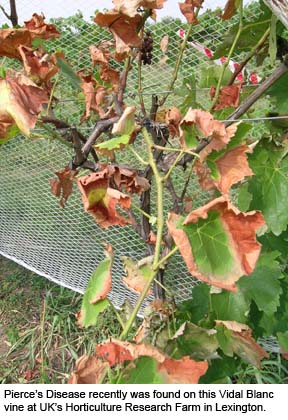Pierce’s Disease Found on Kentucky Grapevine
Pierce’s Disease Found on Kentucky Grapevine


Extension specialists at the University of Kentucky College of Agriculture have identified Pierce’s Disease on a Vidal Blanc grapevine at the university’s Horticulture Research Farm in Fayette County.
UK Viticulturalist Kaan Kurtural said laboratory tests on two different samples were both positive and the affected plant has been removed.
Pierce’s Disease is a deadly grapevine disease spread by certain types of leafhoppers known as sharpshooters. Symptoms include distinct reddish-brown scorching of leaf margins, with the part of the leaf blade nearest the petiole remaining green.
“Other symptoms can include separation of leaf blades from petioles, with petioles remaining on the vine, and alternate green and brown banding along the affected grapevine,” said John Hartman, UK plant pathologist. “Pierce’s Disease is caused by a bacterium called Xylella fastidiosa. The disease can spread from vine to vine in a vineyard, so it’s important to remove affected vines.”
Some Kentuckians may be familiar with X. fastidiosa as a cause of bacterial leaf scorch, a disease causing decline and death of oaks and other landscape trees throughout the state. Although the symptoms are similar and both diseases are fatal, bacterial leaf scorch is caused by a different strain of X. fastidiosa than the strain that causes Pierce’s Disease.
Hartman said recently a case of Pierce’s Disease was suspected in Nelson County, but follow-up sample collection and extensive laboratory testing could not verify the disease there. Leaf scorching symptoms observed in that case may have been due to lack of water due to drought, he said. Drought-scorched leaf margins tend to take on a tan color rather than reddish brown.
Pierce’s Disease has been found in various grape-growing states throughout the United States. According to a report by the University of California at Davis, climatic differences between regions can affect the timing and severity of symptoms, but not the type of symptoms. Hot climates and areas experiencing severe drought accelerate symptoms because moisture stress is more severe even with adequate soil moisture.
The report went further to state that vines of susceptible varieties deteriorate rapidly after appearance of symptoms. Shoot growth of infected plants becomes progressively weaker as symptoms become more pronounced.
“If you suspect you have a vine infected by Pierce’s Disease, collect and deliver the sample to your county Cooperative Extension Service office,” Hartman said. “The agent can submit the samples to our lab for testing.”
